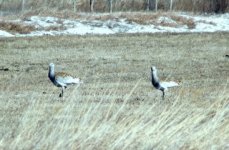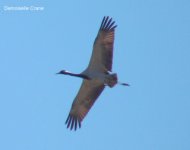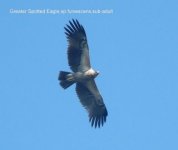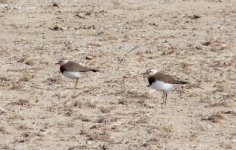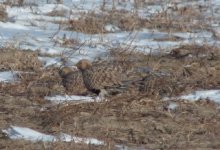This place is my spiritual birdwatching home in northern China and somewhere I would recommend to any birder visiting the Beijing area that they make the effort and visit. It is good at all times of the year but perhaps less so during the months of June and July.
Yeyahu NR and neighbouring Ma Chang are to my mind the premier birdwatching sites in the Beijing area. Surprisingly the area is grossly underbirded and in the three years that I lived in Beijing, having visited the site more than 160 times, apart from regulars like Jesper Hornskov, the highly respected China guide and his parties, I have probably seen no more than 30-40 birders.
The reserve lies approximately 80kms to the NW of Beijing and is reached by the Badaling expressway. There is an excellent bus service from Deshengmen to Yanqing,(first bus leaves 0545hrs) with buses departing every 15-20mins thereafter. The trip depending on delays caused by trucks breaking down, normally takes about one and a half hours.But this can become over two and a half hours with delays,so I got into the habit of busing out to Yanqing on Friday evening, staying overnight at the Kyushu Rapide Hotel (turn right out of the bus station at Yanqing, 200ms on the right) 140Rmb per night. My ever reliable taxi driver Li Yan would look after me like a surrogate mother and pick me up at all hours. Taxi fare to Ma Chang 70Rmb, return trip from Yeyahu NR. 40Rmb.(mob: 13661208497). The taxi ride from Yanqing to Ma Chang takes about 30mins and the return from Yeyahu 20mins.
My regular birdwatching companion Spike Millington and I would normally start at Ma Chang which is an open sandy desert-like area surrounded by crop fields mostly of maize and Peanuts.This is a haven for Cranes (Common,White-naped,Hooded and occasionally Demoiselle and Siberian) as well as the elusive Oriental Plover in the Spring (end of March-mid-May) also occsionally in the Autumn, Great Bustard and raptors.
This is a wonderful location for raptors and it is not unusual to reach double figues for species during a day's birdwatching. Larks are also plentiful including the much sought after Mongolian Lark (Winter). During the very cold winter of 2009/10 flocks of up to 200 birds of this species could be found. This particular winter also produced an irruption of Pallas's Sandgrouse, one notable day I had a count of over 300 birds and another extraordinary record of a dark variant Gyr falcon, a very rare China raptor.
It is worthwhile exploring the area surrounding the wind turbines to the west of Ma Chang (Horse Field) for Great Bustard which are normally seen during the Autumn and early Spring.
You can walk from Ma Chang to Yeyahu NR either through or round the fence that divides the two areas and it is certainly more worthwhile to do os as you will see far more birds than taxi cabbing from one to the other. Daurian Partridge are present in small numbers as well as Japanese Quail. During Winter and Spring the walk produces many Buntings, including the occasional irruption of Pine Buntings (I found a flock of over 300 birds in 2010). I have also recorded the rare Streaked Reed warbler along the edge of the reservoir, where you will also occasionally find Japanese (Ochre-rumped) Reed Buntings.
Yeyahu NR produces a remarkable number of species considering the lack of any forested areas. If you want to find large raptors then head for the area we call Eagle Field which lies between the lake and the reservoir to the north. Late morning in the Spring or Autumn will normally produce something special. Short-toed eagle which is a scarce bird in northern China is easily found here as well as Greater Spotted eagles. During the winter White-tailed eagles are common, but surprisingly Golden eagles are rare at Yeyahu. We have also found Booted eagles and Terry Townshend this year also saw an Imperial. I recorded Himalayan Griffon (2010) at this location. I believe the only Beijing record and I am quite sure Steppe eagles and Lammergeier will one day put in an appearance. Eagle Owls can also be found with regularity in the autumn and spring.They are formidable raptors and regularily take Common Buzzards and Ring-necked Pheasants.Accipiters and Falcons are plentiful depending on the time of the year, with Saker falcons being more common that Peregrines and an occasional Siberian Goshawk being found amongst the Northern Goshawks.During migration it is not uncommon to see migrating flocks of 50+ Amur falcons sometimes with small parties of Lesser Kestrels (best location at the bottom of Ma Chang). I found one flock of over 30 Lesser Kestrels one morning.
All the north Asian Harriers can be found with good numbers of Eastern Marsh (which breed at both Ma Chang and on the lake), Hen,Pied and on four occasions I have seen Pallid harriers. Relict Gulls in the Spring with an occasional Pallas's Gull will show. Terry Townshend this year has also recorded both Great White and Dalmatian Pelicans. Bitterns are common. I estimate there maybe as many as 30 breeding pairs of Great Bitterns, which unlike the UK show very well both on the ground and in flight. Von Schrenck's bittern ,a rare China bird breeds here as well as the ubiquitous Yellow Bittern. If you walk along the boardwalk at the lake in the early morning you will probably find Crakes or Water Rail. The reedbeds also hold breeding Chinese Penduline Tits, one of the very few places that they breed in the Beijing area, perhaps the only location as I know of no other. Last year for the first time we recorded a successful breeding pair of Chinese Grey Shrikes. These birds which are uncommon elsewhere are common at Yeyahu during the winter.
One of my birdwatching friends Richard Carden from Singapore who has visited the site with me on several occasions has a habit of setting me lists of target birds to find. There have only been two glaring misses to the "list" so far, Great Bustard and Eagle Owl neither of which is normally that hard to locate at the appropriate time of the year. However Yeyahu made up for these deficiencies by producing an extralimital male Desert Wheatear and Baird's Sandpiper (yet to be ratified but the ID of which we are both quite certain is correct) as well as a female Pallid harrier.Peter Ericsson, the well-known guide from Bangkok was also present on one of the Red letter days. I would happily take an oath, that there is no such thing as a bad day during a visit to Yeyahu/Ma Chang and you can always count on the "Yeyahu surprise".
There are of course less favourable aspects, not least the "Cavalry" and Dune buggies who are out all year except during the winter in the Ma Chang area. The Cavalry consists of riders often wearing Western gear, who charge hither and thither, yelling like cowboys, but falling off with great regularity. It is quite common to see riderless horses heading back to the corral followed some minutes later by a limping vacquero. Dune buggies have a nice habit of getting bogged down as do the cars full of photgraphers who spend much of their time chasing Northern Lapwings. This is the reason it is worthwhile to arrive at Ma Chang early before the Oriental Plover etc have been disturbed by the "Charge of the Light Brigade". There used to be a problem with boatloads of shooting parties, mist netters, snare trappers and long-doggers, all illegal activities in China. But many of these activities have been curtailed, at least in the short-term, because we took a very pro-active stance against the perpetrators. You will never be able to eliminate poaching in China because there is a complete lack of understanding and caring amongst the local populations but you can make a difference by making a big fuss whenever you find somene setting up a mist net etc.
Finally I would recommend to any birder that they walk and not drive round the area. It will prove so much more rewarding.If you can consider the area has practically no trees and is mostly flat grassland, the 260+ species that we have recorded in the reserve is by the areas standards quite remarkable. I am now working in Shenzhen and discovering new areas to explore which I shall report on a weekly basis. But Terry Townshend has taken up my mantle at Yeyahu and has had a wonderful Autumn -Spring.
Yeyahu NR and neighbouring Ma Chang are to my mind the premier birdwatching sites in the Beijing area. Surprisingly the area is grossly underbirded and in the three years that I lived in Beijing, having visited the site more than 160 times, apart from regulars like Jesper Hornskov, the highly respected China guide and his parties, I have probably seen no more than 30-40 birders.
The reserve lies approximately 80kms to the NW of Beijing and is reached by the Badaling expressway. There is an excellent bus service from Deshengmen to Yanqing,(first bus leaves 0545hrs) with buses departing every 15-20mins thereafter. The trip depending on delays caused by trucks breaking down, normally takes about one and a half hours.But this can become over two and a half hours with delays,so I got into the habit of busing out to Yanqing on Friday evening, staying overnight at the Kyushu Rapide Hotel (turn right out of the bus station at Yanqing, 200ms on the right) 140Rmb per night. My ever reliable taxi driver Li Yan would look after me like a surrogate mother and pick me up at all hours. Taxi fare to Ma Chang 70Rmb, return trip from Yeyahu NR. 40Rmb.(mob: 13661208497). The taxi ride from Yanqing to Ma Chang takes about 30mins and the return from Yeyahu 20mins.
My regular birdwatching companion Spike Millington and I would normally start at Ma Chang which is an open sandy desert-like area surrounded by crop fields mostly of maize and Peanuts.This is a haven for Cranes (Common,White-naped,Hooded and occasionally Demoiselle and Siberian) as well as the elusive Oriental Plover in the Spring (end of March-mid-May) also occsionally in the Autumn, Great Bustard and raptors.
This is a wonderful location for raptors and it is not unusual to reach double figues for species during a day's birdwatching. Larks are also plentiful including the much sought after Mongolian Lark (Winter). During the very cold winter of 2009/10 flocks of up to 200 birds of this species could be found. This particular winter also produced an irruption of Pallas's Sandgrouse, one notable day I had a count of over 300 birds and another extraordinary record of a dark variant Gyr falcon, a very rare China raptor.
It is worthwhile exploring the area surrounding the wind turbines to the west of Ma Chang (Horse Field) for Great Bustard which are normally seen during the Autumn and early Spring.
You can walk from Ma Chang to Yeyahu NR either through or round the fence that divides the two areas and it is certainly more worthwhile to do os as you will see far more birds than taxi cabbing from one to the other. Daurian Partridge are present in small numbers as well as Japanese Quail. During Winter and Spring the walk produces many Buntings, including the occasional irruption of Pine Buntings (I found a flock of over 300 birds in 2010). I have also recorded the rare Streaked Reed warbler along the edge of the reservoir, where you will also occasionally find Japanese (Ochre-rumped) Reed Buntings.
Yeyahu NR produces a remarkable number of species considering the lack of any forested areas. If you want to find large raptors then head for the area we call Eagle Field which lies between the lake and the reservoir to the north. Late morning in the Spring or Autumn will normally produce something special. Short-toed eagle which is a scarce bird in northern China is easily found here as well as Greater Spotted eagles. During the winter White-tailed eagles are common, but surprisingly Golden eagles are rare at Yeyahu. We have also found Booted eagles and Terry Townshend this year also saw an Imperial. I recorded Himalayan Griffon (2010) at this location. I believe the only Beijing record and I am quite sure Steppe eagles and Lammergeier will one day put in an appearance. Eagle Owls can also be found with regularity in the autumn and spring.They are formidable raptors and regularily take Common Buzzards and Ring-necked Pheasants.Accipiters and Falcons are plentiful depending on the time of the year, with Saker falcons being more common that Peregrines and an occasional Siberian Goshawk being found amongst the Northern Goshawks.During migration it is not uncommon to see migrating flocks of 50+ Amur falcons sometimes with small parties of Lesser Kestrels (best location at the bottom of Ma Chang). I found one flock of over 30 Lesser Kestrels one morning.
All the north Asian Harriers can be found with good numbers of Eastern Marsh (which breed at both Ma Chang and on the lake), Hen,Pied and on four occasions I have seen Pallid harriers. Relict Gulls in the Spring with an occasional Pallas's Gull will show. Terry Townshend this year has also recorded both Great White and Dalmatian Pelicans. Bitterns are common. I estimate there maybe as many as 30 breeding pairs of Great Bitterns, which unlike the UK show very well both on the ground and in flight. Von Schrenck's bittern ,a rare China bird breeds here as well as the ubiquitous Yellow Bittern. If you walk along the boardwalk at the lake in the early morning you will probably find Crakes or Water Rail. The reedbeds also hold breeding Chinese Penduline Tits, one of the very few places that they breed in the Beijing area, perhaps the only location as I know of no other. Last year for the first time we recorded a successful breeding pair of Chinese Grey Shrikes. These birds which are uncommon elsewhere are common at Yeyahu during the winter.
One of my birdwatching friends Richard Carden from Singapore who has visited the site with me on several occasions has a habit of setting me lists of target birds to find. There have only been two glaring misses to the "list" so far, Great Bustard and Eagle Owl neither of which is normally that hard to locate at the appropriate time of the year. However Yeyahu made up for these deficiencies by producing an extralimital male Desert Wheatear and Baird's Sandpiper (yet to be ratified but the ID of which we are both quite certain is correct) as well as a female Pallid harrier.Peter Ericsson, the well-known guide from Bangkok was also present on one of the Red letter days. I would happily take an oath, that there is no such thing as a bad day during a visit to Yeyahu/Ma Chang and you can always count on the "Yeyahu surprise".
There are of course less favourable aspects, not least the "Cavalry" and Dune buggies who are out all year except during the winter in the Ma Chang area. The Cavalry consists of riders often wearing Western gear, who charge hither and thither, yelling like cowboys, but falling off with great regularity. It is quite common to see riderless horses heading back to the corral followed some minutes later by a limping vacquero. Dune buggies have a nice habit of getting bogged down as do the cars full of photgraphers who spend much of their time chasing Northern Lapwings. This is the reason it is worthwhile to arrive at Ma Chang early before the Oriental Plover etc have been disturbed by the "Charge of the Light Brigade". There used to be a problem with boatloads of shooting parties, mist netters, snare trappers and long-doggers, all illegal activities in China. But many of these activities have been curtailed, at least in the short-term, because we took a very pro-active stance against the perpetrators. You will never be able to eliminate poaching in China because there is a complete lack of understanding and caring amongst the local populations but you can make a difference by making a big fuss whenever you find somene setting up a mist net etc.
Finally I would recommend to any birder that they walk and not drive round the area. It will prove so much more rewarding.If you can consider the area has practically no trees and is mostly flat grassland, the 260+ species that we have recorded in the reserve is by the areas standards quite remarkable. I am now working in Shenzhen and discovering new areas to explore which I shall report on a weekly basis. But Terry Townshend has taken up my mantle at Yeyahu and has had a wonderful Autumn -Spring.




